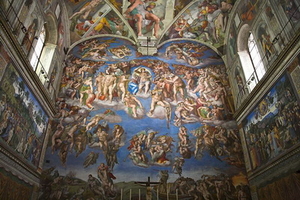The canonization of Brother André brought many Montrealers to Rome. Inevitably they will complain about the long line-ups to visit the Sistine Chapel but will they have uncovered the secrets of the Sistine Chapel? Viewing the work of Michelangelo is breathless but does the Chapel still hold its secrets from the average visitor. The incredible frescoes required a rather complex method to prepare the plaster before the first stroke of the paintbrush would bring color to life. Imagine Michelangelo laying on his back for four and a half years painting the entire ceiling and walls of ceiling and walls of the Chapel. The Chapel is a replica, of identical size, of the Jerusalem Temple and symbolized the successionism of Catholicism over Judaism. The masterpiece has, from the time of its painting, been regarded as an affirmation of the Roman Catholic Church’s central place in the economy of salvation.
Here in Montreal Mary Queen of the World Cathedral in Montreal is another example of replicating beliefs in buildings. Though the scale is 1 to 9 it is a proportional replica of the Saint Peter’s in Rome and this was to affirm the power of the Pope, the teaching of Ultramontanists. The Church of the Pope, as the Bishop of Rome, is not St. Peter’s, but San Giovanni in Laterano. The Sistine Chapel is the four and a half year work of the finest painter and sculptor of all times, Michelangelo. He was commissioned by Pope Julius IInd to paint the Chapel against his will and against his better instincts to be a sculptor. Michelangelo detested Julius II for this reason and the secrets of the Chapel were that he painted the whole of the ceiling and the walls of the Chapel as an affront to the kind of Church of Julius II was espousing and as a personal attack on him.
 The 1980’s restoration of the Chapel was financially backed by a Japanese Television Network (Sayonara Michelangelo – The Sistine Chapel Restored and Repackaged by Waldemar Januszczak. Addison Wesley. 1990) and disclosed new findings which had remained hidden for centuries under the dirt and grime that covered the ceiling and walls. A traditional Christian understanding of the Chapel can be found in Michelangelo and the Sistine Chapel by Andrew Graham-Dixon. (Weidenfield &Nicolson. London. 2008) However, Rabbi Benjamin Blech and Roy Doliner (The Sistine Secrets – Michelangelo’s Forbidden Messages in the Heart of the Vatican. HarperOne. NY. 2008) with the renewed frescoes found that Michelangelo had indeed painted from the teachings of the Jewish Kaballah. A final blow to who Julius was and that for which he stood. Blech and Dolimer offer a truly fascinating interpretation of the Chapel, and conclude: “Michelangelo knew that for the Church to fulfill the will of God it had to become a paradigm of true brotherhood. There had to be a bridge between rich and poor, between privileged and downtrodden, between those who spoke ostensibly for God and those who desperately needed divine assistance. Thus, Michelangelo filled the chapel with hidden messages of his passionate loves and his righteous rages, along with mystic symbols of divine justice and divine mercy. For him the Sistine was indeed the Sanctuary, the neck of the world, but more than that, it was “The Bridge” – the bridge meant to unite people with God, with their fellow humans, and perhaps more difficult of all with their own spiritual selves.” (p.306) A visitor to the Sistine Chapel, after reading Bleck and Doliner, may be very surprised.
The 1980’s restoration of the Chapel was financially backed by a Japanese Television Network (Sayonara Michelangelo – The Sistine Chapel Restored and Repackaged by Waldemar Januszczak. Addison Wesley. 1990) and disclosed new findings which had remained hidden for centuries under the dirt and grime that covered the ceiling and walls. A traditional Christian understanding of the Chapel can be found in Michelangelo and the Sistine Chapel by Andrew Graham-Dixon. (Weidenfield &Nicolson. London. 2008) However, Rabbi Benjamin Blech and Roy Doliner (The Sistine Secrets – Michelangelo’s Forbidden Messages in the Heart of the Vatican. HarperOne. NY. 2008) with the renewed frescoes found that Michelangelo had indeed painted from the teachings of the Jewish Kaballah. A final blow to who Julius was and that for which he stood. Blech and Dolimer offer a truly fascinating interpretation of the Chapel, and conclude: “Michelangelo knew that for the Church to fulfill the will of God it had to become a paradigm of true brotherhood. There had to be a bridge between rich and poor, between privileged and downtrodden, between those who spoke ostensibly for God and those who desperately needed divine assistance. Thus, Michelangelo filled the chapel with hidden messages of his passionate loves and his righteous rages, along with mystic symbols of divine justice and divine mercy. For him the Sistine was indeed the Sanctuary, the neck of the world, but more than that, it was “The Bridge” – the bridge meant to unite people with God, with their fellow humans, and perhaps more difficult of all with their own spiritual selves.” (p.306) A visitor to the Sistine Chapel, after reading Bleck and Doliner, may be very surprised.
A Kabbalah primer: Yehuda Berg. the power of kabbalah – Technology for the Soul. Kabbala Centre International. New York. 2004).

























Comments
Please login to post comments.